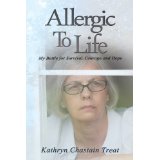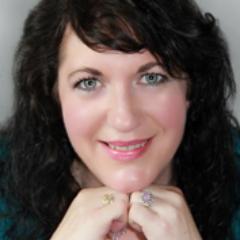A year ago today Kathryn Chastain Treat died suddenly of a cerebral hemorrhage. I published this post in her honor after I heard the sad news from one of her daughters. To mark the first anniversary of Kathy’s death, I am re-publishing my 2014 post.
Nothing prepares you for sudden loss. Not training, not faith, not personal fortitude. When loss occurs suddenly, the first reaction is disbelief, followed by a nearly all-encompassing paralysis of thought. At least, that’s how it was for me when Kathy Treat’s daughter Laura told me of her mother’s sudden death this weekend due to a cerebral hemorrhage. How could it be otherwise? A person I had known as a vibrant fully engaged human being, someone who had been a dear friend to me for over twelve years, was suddenly gone. And the only thing I could think of in that moment, the thought that was repeating in my mind, was that I had to write about her. That thought drove me to my computer.

Kathryn Chastain Treat is the author of Allergic to Life: My Battle for Survival, Courage, and Hope. In her book, Kathy shared her years-long battle to recover from mold exposure in her workplace and detailed the various treatments she underwent, some of which worked and some of which did not. If there were dominant themes that tied her story of illness, survival, and triumph together, they were her out-sized courage and her decades-long quest to educate doctors, nurses, and other medical personnel about multiple chemical sensitivity (MCS). And she was a great guide and friend to others with MCS. In her blog posts, she shared information about the various treatments that had worked for her and others, pointed a finger at the sources of pollution— industrial, commercial, and personal—that harm all of us, not just the chemically sensitive, and supported other bloggers who were helping to shine a light on the environment and health, as well as the increase in the incidence of MCS. She was also a loyal and dedicated member of the Rave Reviews Book Club, who served as the club’s first Membership Director until illness and the loss of her father required she take a less active, but still utterly engaged, role. Finally, and certainly most important to a retelling of who Kathy was, she was a devoted daughter, sister, wife, mother, grandmother, and friend.
I met Kathy in January 2003 at Dr. Rea’s clinic, the Environmental Health Center-Dallas, under what were trying circumstances for both of us. I had been in Dallas since October 2002 under treatment for chronic and acute exposure to type II pyrethroid pesticides, which are still considered in the United States to be safe for people and pets. Kathy, who had initially been in treatment at Dr. Rea’s clinic for mold exposure in 2002, had returned to Dallas to have her uterus and ovaries removed in January 2003, an ordeal she wrote about in detail in her book. While a hysterectomy is stressful and debilitating for most women and recovery is not easy, Kathy’s was made even more so by the knowledge that her uterine and ovarian tissue contained high levels of trichothecene mycotoxins, toxic secondary metabolites or byproducts of mold.
Despite the obstacles to recovery Kathy encountered and the debilitating bouts of dizziness, compounded by anaphylactic reactions to medicines as well as to the testing of antigens that would eventually bring her allergic reactions under control, she remained determined to help herself and to be a friend to the other patients she met at the clinic and the Regina Coeli apartments, where we met.
As people do when they are joined in adversity, Kathy bonded with several patients, and I was one of those fortunate to meet and bond with Kathy. As she recovered from her surgery and became stronger, we shared the time we were not testing at the clinic, sitting in my apartment and not Kathy’s because in addition to MCS I had also unmasked for sensitivity to electromagnetic fields. In my apartment I was furthest from the strongest sources of EMF radiation in the apartment building, and I could manage best there. Kathy, considerate and thoughtful, made it her business to learn about EMF sensitivity and helped me with tasks I could not manage on my own.
One of those tasks was washing and drying clothing. I needed to avoid going into the laundry room when the washers or dryers were running. Since there was no schedule for use, invariably I found myself having to move my clothes to the dryer or take them out when someone else was already running a wash or dry cycle in another machine. I had been depending on friends I had made at the apartments, but finding someone at the right moment wasn’t always possible. Kathy said that Regina Coeli needed to have a laundry room schedule, and I agreed. We sat one afternoon working on a grid by two-hour time segments for the use of the washers and dryers in the laundry room. Later that evening when we had finished, I presented the grid to Earl Remmel, the proprietor, who loved the idea and hung up a grid-like sign up board in the laundry room for residents to fill in. EMF exposure problem solved! And it was Kathy’s idea.
When it was time for me to leave Dallas for an environmentally safe house in Santa Fe, Kathy and another friend, Anne, helped me pack up to leave. I had been in a healing crisis and was in too much pain to do much of anything except rest. In Santa Fe, Kathy and I kept in touch while she was in Dallas and after she returned home to Merced. Since I was still recovering from EMF sensitivity, we could only exchange handwritten notes. It was not until a few months later that I could begin to have telephone conversations, albeit short ones to limit my exposure to EMF.
As I healed from EMF sensitivity with help from Deborah Singleton and the healing team at A Healing Place, I could once again use a computer and speak on the telephone for longer periods. Then Kathy and I could exchange emails about the book I was writing and Kathy’s plan to turn her journal entries into the story of her battle with mold exposure. Kathy was one of my biggest supporters as I was dealing with the various stages of editing and proofreading with my publisher. In turn after she had decided to self-publish and had entered the editing process through a friend of her daughter Laura, we explored the many avenues to publication.
Kathy published Allergic to Life: My Battle for Survival, Courage, and Hope in August 2013. She planned and cooked for her launch party, choosing an outside setting, one that would make it easier for her to be in a large group of people. If everyone followed her request not to wear scent, then she could mingle easily and not be exposed to the outgassing of materials as she would have in an indoor setting. The party was a success, of course.
In December 2013 Kathy told me of a new online book club, of which she was to be a founding member. The brainchild of Nonnie Jules, Rave Reviews Book Club would promote Indie writers and their work. Although I was published by a small publisher in the UK, Kathy said I would be welcome, and she urged me to join. I am glad I did. RRBC has been incredibly supportive on social media and is a home away from home for beginning and seasoned writers. Their promotional activities have brought me and other writers followers on Twitter, Facebook, and WordPress and increased sales.
The fact that I have a WordPress blog at all is due to Kathy’s guidance and help. When my book website was hacked and used as a phishing site, it had to be taken down. After working with a young computer geek for several weeks to try to restore it, I realized that it was a lost cause. Kathy volunteered to guide me in setting up a WordPress blog. She helped me style my page, connect it to social media with the right widgets, and taught me in telephone conversations how to edit and post. Within a day my blog was running, and I began posting.

Kathryn and her husband, Rick.
Just as she was a loyal friend to me and to others, she was devoted to her family. And they figure prominently in Allergic to Life. Anyone who reads Kathy’s book will learn of her devotion to her parents, sister, husband, children, and grandchildren. She writes movingly of her feelings when she was in treatment in Dallas and had to miss birthdays and other celebrations with her daughters back home. Her family returned that devotion and love in many ways. They were supportive of Kathy while she was in treatment in Dallas and at home. Kathy shared photos of family holidays in her blogs, where her family wore Tyvek suits to protect Kathy from mold exposure. They de-scented themselves for her and made their homes as environmentally safe as they could so Kathy could visit. Kathy and I had heard stories from other clinic patients whose families were not supportive and made no effort to help the person in treatment. We had both felt so grateful that our families had stood by us through treatment and afterwards.
Kathy was an ordinary woman who walked an extraordinarily difficult path with courage and determination. She mastered the technical terms of the health consequences of mold exposure and educated those who would listen. She was a role model for me and many others. Her kindnesses and achievements will not be forgotten.
Kathy, I will miss you, my dear friend and fellow author.





![img_2869_1[1]](https://jsherwinblog.files.wordpress.com/2015/01/img_2869_11.jpg?w=300&h=239)
![images[6]](https://jsherwinblog.files.wordpress.com/2014/10/images6.jpg?w=479)
![images[10]](https://jsherwinblog.files.wordpress.com/2014/10/images10.jpg?w=479)
![danger_pesticides[1]](https://jsherwinblog.files.wordpress.com/2014/10/danger_pesticides1.jpg?w=300&h=225)
![images[3] (2)](https://jsherwinblog.files.wordpress.com/2014/10/images3-2.jpg?w=479)

![book-club-badge-suggestion-copy-1[1]](https://jsherwinblog.files.wordpress.com/2014/07/book-club-badge-suggestion-copy-11.jpg?w=300&h=122)
![images[9]](https://jsherwinblog.files.wordpress.com/2014/04/images9.jpg?w=479)

![HoneyBees[1]](https://jsherwinblog.files.wordpress.com/2014/04/honeybees1.jpg?w=300&h=219)

![pesticide-spraying[1]](https://jsherwinblog.files.wordpress.com/2014/04/pesticide-spraying1.jpg?w=300&h=207)







![images[2]](https://jsherwinblog.files.wordpress.com/2014/03/images2.jpg?w=150&h=67)












